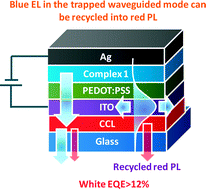Efficient solid-state white light-emitting electrochemical cells employing embedded red color conversion layers
Abstract
Recently, white light-emitting electrochemical cells (LECs) have attracted scientific attention due to their advantages of simple device structure, low operation voltage and compatibility with solution processes. In this work, efficient white emission from blue-emitting LECs with embedded red color conversion layers (CCLs) is reported. The red CCL is embedded between an indium tin oxide (ITO) layer and a glass substrate. The blue electroluminescence (EL) trapped in the waveguided mode, i.e. in the ITO layer, shows an evanescent tail in the CCL layer and excites the red-emitting dye, generating red photoluminescence (PL). Because the trapped blue EL can be partially transferred to the out-coupled red PL, the doping concentration of the red dye in the CCL can be reduced, and thus the absorption loss of the blue EL in the forward direction (air mode) can be mitigated, rendering enhanced device efficiency. The peak external quantum efficiency and power efficiency obtained in the blue-emitting LECs with embedded red CCLs are up to 12.5% and 27 lm W−1, respectively. These values are among the highest reported for white LECs, and thus confirm that blue-emitting LECs containing embedded red CCLs are capable of providing efficient white emission.


 Please wait while we load your content...
Please wait while we load your content...